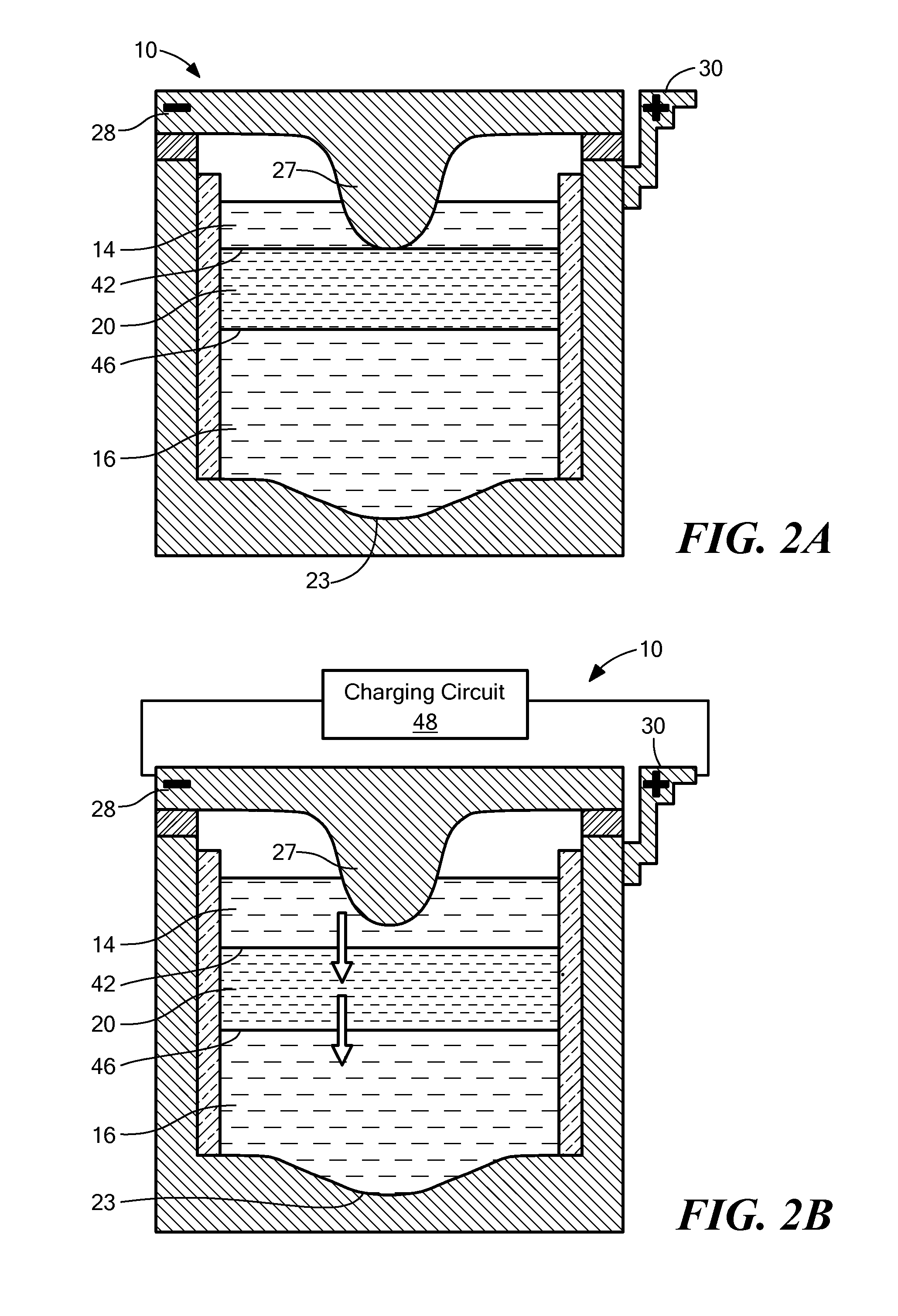Low-Temperature Liquid Metal Batteries for Grid-Scaled Storage
a low-temperature, battery technology, applied in the direction of electrochemical generators, secondary cells servicing/maintenance, waste accumulators, etc., can solve the problems of inability to be productive when needed, inability to efficiently store electrical energy, and inability to easily switch off sources of energy, such as nuclear plants, to achieve the effect of reducing the number of grid-scale storage devices
- Summary
- Abstract
- Description
- Claims
- Application Information
AI Technical Summary
Benefits of technology
Problems solved by technology
Method used
Image
Examples
example 1
The Na—Hg System
[0075]The sodium-mercury system provides components with extremely low melting point, relatively inexpensive active materials, suitable voltage, compatibility with common cell engineering materials. The eutectic composition of NaOH and NaI was chosen as the electrolyte to achieve suitable ionic conductivity at the lowest operating temperature. The operating temperature of the cell is 275° C.
[0076]FIG. 5 shows the discharge and charge curve for a Na|NaOH—NaI—Hg cell, using a cell with approximately 5% sodium in the positive electrode ab initio. The results confirm the starting voltage (which can also be theoretically calculated from the literature) to be between 774 mV and 778 mV.
[0077]As shown in FIG. 6, further tests of the NaOH—NaI electrolyte system show low leakage currents. FIG. 6 shows a leakage current measurement made in fully assembled Na—Hg 3 Ah cells. As shown, the current decays down to 1.5 mA for a system with an active surface area of 2 cm2. Thus, the l...
example 2
The Na—Pb / Sb System
[0079]A Na—Pb / Sb system was developed as another low temperature chemistry because of the high theoretical potential of the Na—Sb alloy, and because alloying Sb with Pb effectively lowers the melting temperature of the alloy without sacrificing excessive potential. The NaOH—NaI eutectic electrolyte was utilized to build the cells. For the alloy at the anode, 18 atomic % of Pb in Sb was used. The operating temperature of the cell was 275° C.
[0080]A stable potential was achieved after partially charging the cell (see FIG. 8), indicating that the self-discharge current was low. The cell was also able to reversibly charge from an open circuit potential of 0.4V to 0.6V, then discharge again to 0.4V (FIG. 9).
example 3
The Na—Pb / Bi System
[0081]A low operating temperature Na-Pb / Bi cell was prepared with 20 mol % Pb alloyed with Bi. As shown in FIG. 10, the Na—Pb / Bi cell having 38 cm2 area and operated at 275° C. has a low leakage current of 7 mA / cm2. In comparison, known Na—Bi cells (without Pb) operated at the elevated temperature of 560° C. were found to have a leakage current in the order of 25 mA / cm2.
[0082]Similar to the Na—Pb / Sb system, the Na—Pb / Bi cell was partially charged and held at open circuit to confirm a stable voltage was attained. As can be seen in FIG. 11, the open circuit potential was found to be stable at 0.68V.
[0083]A cyclic voltammetry experiment was conducted on the NaOH—NaI eutectic electrolyte (80 / 20 mole %, respectively), and the resulting plot is shown in FIG. 12. In this experiment, the counter and working electrodes were Ag, and the reference electrode was Na inside of a beta Al cup. The temperature of the experiment was 257° C. conducted in an argon atmosphere of 1 atm...
PUM
 Login to View More
Login to View More Abstract
Description
Claims
Application Information
 Login to View More
Login to View More - R&D
- Intellectual Property
- Life Sciences
- Materials
- Tech Scout
- Unparalleled Data Quality
- Higher Quality Content
- 60% Fewer Hallucinations
Browse by: Latest US Patents, China's latest patents, Technical Efficacy Thesaurus, Application Domain, Technology Topic, Popular Technical Reports.
© 2025 PatSnap. All rights reserved.Legal|Privacy policy|Modern Slavery Act Transparency Statement|Sitemap|About US| Contact US: help@patsnap.com



